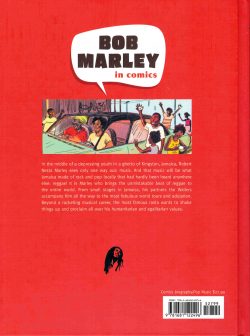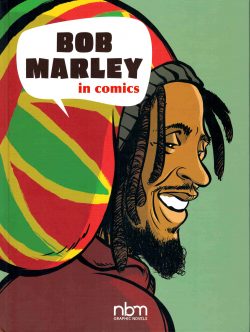

By Gaets & Sophie Blitman, illustrated by Olivier Desvaux, Ammo, Didier Millotte, Tanguy Pietri, Matthieu Beaulieu, Jena, Efix, Domas, Simon Léturgie, Sarah Williamson, Cyrille Brégère, Julien Modde, Moh, Armel Ressot, Lu-K, Clément Baloup, Joël Alessandra, Julien Atika, Gil & various: translated by Montana Kane (NBM)
ISBN: 978-1-68112-250-2 (HB)
Graphic biographies are all the rage at the moment and this one – originally released on the continent in 2018 – is another cracker likely to appeal to a far larger mainstream audience than comics usually reach. It certainly deserves to as it captivatingly deconstructs the life of a truly unique force in music and popular culture…
If you’ve never heard of Bob Marley or don’t like reggae, you might still want to check this out. The singer was deeply spiritual and it’s never too late to see the light and convert or, failing that, just buy a record…
Gathered in this fetching hardback (or eBook) edition are context-providing essays backing up individual comics sections; each chronological article and comics vignettes written by the ever-informative comics scribe Gaets and journalist/children’s author Sophie Blitman, supported by a veritable legion of illustrators providing vivid and vibrant strips, beginning with ‘From Nesta to Robert’ – limned by Olivier Desvaux.
The early life of the musician introduces us to his mother Cedella Malcolm and the old white soldier she married. With Norval Marley disinherited and promptly absconding, Nesta Robert Marley spent his early years in the rural farming community of Nine Miles in Jamaica until at age six, when he was whisked away to Kingston by his dad… who simply dumped him with another woman and vanished again…
Happily, a few years later Cedella joined the boy who was already showing promise as both a fortune telling mystic and award-winning singer. Rendered in stark monochrome by Ammo, ‘The Rude Boys of Trenchtown’ exposes the appalling poverty Nesta endured and the lasting friendships that privation engendered as they played, made music and hung out together: relationships expanded upon in the essay ‘Growing Up Between Worlds’.
Working in muted full colour, Didier Millotte explores ‘Reggae in the Ghetto’ as Robert Marley – now working as a full-time (14-year-old) welder – and his mates Peter Tosh and Bunny Wailer are taken under the wing of pro musician Joe Higgs who teaches young Marley to play guitar…
‘Making Friends in Trenchtown’ details the development of the musical genre Reggae from Ska and Marley’s growing influence after which Tanguy Pietri illuminates sordid conditions and lack of opportunities which compel him to make music his life in ‘A Ray of Light in the Dark’…
Matthieu Beaulieu reveals the unique way poor Jamaicans consumed pop music in ‘Sound Systems, Ska & Studio One’, how the blossoming star is ripped off for the first – of many – times and how he meets wife-to-be Rita Anderson: a relationship which grows in Jena’s vignette ‘Is This Love?’
Efix delineates Marley’s spiritual growth in historical lecture ‘The Roots of the Rasta Movement’, whilst Domas’ ‘Tuff Gong in Nine Miles’ follows his musical journey to America – until the threat of being drafted into Vietnam – and ultimately to London, where The Wailers become stranded…
Essay ‘The Path to Success’ concentrates upon Marley’s song-writing and musical self-determination which led to the critical meeting with British Producer Chris Blackwell in ‘The Reggae Wave’ (art by Simon Léturgie) and the release of first album Catch a Fire. Now a growing global sensation among young white music fans – as detailed in essay ‘An “International Reggae‒ – Bob Marley and The Wailers retire to Blackwell’s ‘Villa Rasta’ (illustrated by Sarah Williamson), to make more music and bask in fame in their own country whilst enjoying a few rock star trappings of success…
One such is covered in ‘Bob Marley, Rita… And All the Other Women’, recounting the numerous affairs and children the singer indulged in even as the parade of mega-hits began. Cyrille Brégère encapsulates the tone of the times in ‘The Sheriff Died Tonight’ with the financial sharks already circling, as seen in ‘Around the World’ (Julien Modde), leading to the breakup of the founding members…
Throughout this period, Jamaica was descending into political chaos and gangsterism fuelled by economic disparity. This was something no amount of interviews or comments from the pacifist, life-loving musician could affect, but did result in the assassination attempt depicted by Moh in ‘Panic in the Hen House’.
The spark was believed to be proposed peace and reconciliation concert Smile Jamaica, but despite being wounded, three days later the show went on with Marley proudly in the spotlight…
Following more history in ‘The Price of Fame’, Armel Ressot graphically caters a ‘Punk Reggae Party’ as the leading proponents of two landmark musical movements meet and cross pollinate, despite falling foul of British Law, after which ‘From Exile to Exodus’ covers the creation of the classic album before ‘Red Card’ (art by Lu-K) heralds the beginning of the end after an impromptu kickabout in Paris leads to a shocking discovery…
The star’s obsessive passion for the sport of the ghettos is examined in ‘Bob Marley and His Love of Soccer’, as is his refusal to compromise his Rastafari principles by accepting medical treatments unacceptable to his faith. Clément Baloup then pictorially details the escalating civil war in Kingston and Marley’s controversial pre-election solution of a One Love Peace Concert in ‘Ablaze’.
Knowing his end was near, Marley finally visited Ethiopia in 1978 before finishing the album Survival and discovering yet another friend and manager had been stealing from him and his fans. He played controversial concerts in Africa – including the independence ceremony of recently liberated and newly-created Zimbabwe – twice in fact, as the authorities cut the first one short through force of arms – as seen Joël Alessandra’s ‘Roots’.
Penultimate essay ‘For Peace and Unity Among Peoples’ shares his philosophies, awards and legacy, via the peace concerts he headlined, backed up by a moving strip of his final days in ‘All the Way’ (by Julien Atika), after which closing essay ‘Death of the “Pope of Reggae‒ fills in the detail of his passing and ‘What Next?‘ by Gil closes the show with the events of the Tuff Gong’s state funeral and his musical legacy, courtesy of his many children.
Bob Marley in Comics is an astoundingly readable and beautifully rendered treasure for comics and music fans alike: one that resonates with anybody who loves to listen and look. Without it, you’re simply nowhere, man…
© 2016 Petit as Petit. © 2018 NBM for the English translation.
Bob Marley in Comics will be released in the UK in February 2020 and is available for pre-order now. NBM books are also available in digital formats. For more information and other great reads go to NBM Publishing at nbmpub.com
